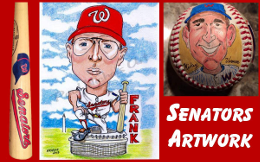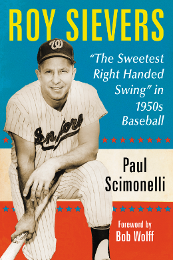It was great to be at the Nationals Park on Jackie Robinson Day. Even if the crowd was sparse in the cool, wet weather, it was heartwarming to see all the players wearing No. 42 in honor of the man who broke baseball’s color barrier.
Reflecting on the legacy of Robinson and those who followed him, it’s appropriate to look back at the Washington’s own history of civil rights and baseball as examples of how far sport and society have come, and to see how far we still have to go.
Washington was the scene of a major milestone in the integration of baseball. On April 11, 1966, Emmett Ashford became the first African American major league umpire, when Cleveland and the expansion Senators met at D.C. Stadium. Racial tension almost kept that historic event from happening. Vice President Hubert Humphery’s security detail in the parking lot had to be convinced that Ashford really was an umpire.
In the sixth inning, Ashford hustled down the left field line and pointed emphatically to call “fair ball” on Frank Howard’s first home run a Senator, a two-run shot off Sam McDowell. It helped set a new standard for umps, who had historically been more stationary and used more subtle gestures.
Ashford’s milestone changed the game for the better as much as Robinson’s did. However, the fact that it took another 19 years to come about is evidence of how stubborn the game and the men who ran it could be, including the men who ran the game in the nation’s capital.
When the original Nats were winning games and drawing big crowds in the 1920s and early 30s, the city’s black community was an integral part of their fan base. Griffith Stadium was blocks from historically black Howard University. The stadium was not officially segregated, but black fans at Senators games were generally confined to the right field pavilion. At other times, the ballpark was a hub for the city’s growing black community – the home of high school sports, an annual drill competition and other events.
Jazz great Duke Ellington sold hot dogs there as a youngster. Legendary sports writer Sam Lacy, who would become the driving force for integration, fell in love with the game while shagging fly balls and running errands for the likes of Walter Johnson, Chick Gandil and Clyde Milan. As sports editor of the Washington Tribune and later with the Baltimore and Washington Afro-American newspapers, Lacy called out white owners for digging in their heels.
In 1937, Lacy interviewed Senators owner Clark Griffith, who told Lacy he did not favor immediate integration but also predicted it would eventually happen. Historians disagree on Griffith’s motives.
Griffith would oppose Robinson’s signing by the Dodgers in 1947 and did not officially integrate his team until late 1954, signing the Cuban-born Carlos Paula. Griffith was known for decades for signing Cuban players, including, Bobby Estalella, whom Washington Post legend Shirley Povich writes endured racist epithets from white opponents.
Griffith also rented his ballpark to the Negro National League’s Homestead Grays after they moved to Washington in 1940, attended many home games and even scheduled Negro World Series games at Griffith Stadium. However, Grays historian Brad Snyder writes that Griffith could have signed away future Hall-of-Famers Josh Gibson and Buck Leonard in 1943, but refused because he was making big money from the Grays, who became the favorites of black fans as the Senators were fading.
Griffith was also aware of other great black ballplayers. Senators star Mickey Vernon served with Larry Doby during World War II and wrote to Griffith, praising Doby’s talents. Yet Doby signed with Cleveland in 1947, breaking the American League color barrier.
Griffith’s biographers deny any greed or racism. Brian McKenna writes that Griffith was sincere in his support for the Grays and the Negro Leagues, and thought they should grow strong enough to compete with the majors. Ted Leavengood writes that Griffith never spoke a racist word, and that Washington in the 1940s or early 50s might not have supported an integrated team.
Griffith died less than a year after officially integrating his team, so there will always be some mystery about him. However, years after the team’s 1961 move to Minnesota, nephew Calvin Griffith, who took over for his uncle, was more transparent about his reasons.
Baseball has clearly come a long way 71 years after Robinson made history, yet there are still issues to overcome. African Americans are vastly underrepresented in major league front office and managerial positions. Hank Aaron says he still received hate mail 40 years after breaking Babe Ruth’s career home run mark. Baltimore’s Adam Jones, a vocal advocate for progress, was taunted last season in Boston. Surely, we can all call on our common love for the game to make it all it can be.






